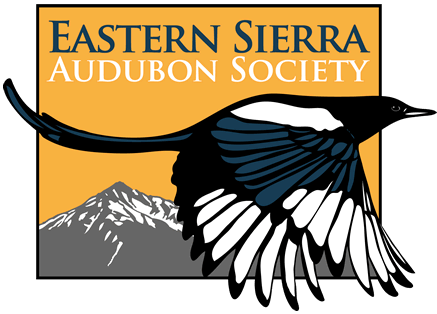[Originally appeared in the Sierra Wave newsletter, Vol. 28, No. 5, May-Jun 2010 – click here for original with photos]
The thrush family, Turdidae, is found almost worldwide and, with over 300 species, is one of the largest families in the avian world. Just over twenty species have been documented in the United States and Canada and ten of them have occurred in Inyo and Mono Counties. Many thrushes are recognized as some of the finest songsters in nature with an appearance that can vary from cryptic to colorful. Not all thrushes contain that word in their common name, ergo bluebirds, solitaires, and robins are all thrushes.
Of the ten species found locally, seven occur annually and three are casual vagrants, meaning they not seen every year and not expected to be seen at all in the Eastern Sierra. Of the seven species found here, only two are not found year-round; the Swainson’s Thrush is a migrant and the Varied Thrush is a winter visitor.
Bluebirds are the most brightly colored thrushes that occur in our region. The Western Bluebird has been recorded throughout Inyo County and throughout the year but it is not a permanent resi- dent because different populations occur during different seasons. This species is a local and uncommon breeder in Inyo County choosing the pinyon belt of the Panamint Range and a few lower elevation locations scattered along the east slope of the Sierra. They are hole-nesters and compete with other hole-nesters for sites, such as Western Screech-Owls and Northern (Red-shafted) Flickers. One of the most reliable winter locations is China Ranch in the southeast corner of the county near Tecopa. There are a few breeding records in Mono County but Western Bluebirds are not regular breeders there.
The Mountain Bluebird is found widespread in Inyo and Mono, and in fact are the state bird of Nevada. They also are hole-nesters and are most often found in summer near mountain meadows with forest-lined borders, which supply the nest cavities they need. They are also known to nest at slightly lower elevations in pinyon-juniper woodland bordering open areas, which they use for foraging. In winter, when snow covers their breeding grounds, they move downslope and 200-300 birds have been found in alfalfa fields in the Owens Valley and smaller numbers can stake out pyracantha bushes where they stay until the last berry is eaten.
The Townsend’s Solitaire, owner of a supreme voice, is an uncommon resident of the Sierra where it breeds in coniferous forest; it is also found in the mountain ranges to the east but in fewer numbers. In winter, they may be locally fairly common where one of their favorite foods, juniper berries, is abundant.
The American Robin is recorded throughout the Eastern Sierra and throughout the year, but again different populations occur during different seasons. In Inyo County it is a common migrant and summer resident, found on lawns and riparian on the valley floor and meadows, riparian, and coniferous forest in the mountains. In winter they are regularly found at lower elevations but in much larger numbers than the rest of the year. While not unprec- edented, finding a flock of hundreds feeding on juniper berries is an exciting experience.
The Hermit Thrush is the expected spotted thrush from the high country of Inyo and Mono Counties. Many consider the flute-like song the most beautiful sound in nature. Fortunately, the species is fairly common along the east slope of the Sierra and in the mountains to the east and can be heard on hikes in coniferous forests from May to August.
The Swainson’s Thrush is a fairly common spring migrant throughout Inyo County in riparian and coniferous forest but it is rarely reported in fall. There is one Inyo breeding record when recently fledged juveniles were found at Coyote Flat, west of Bishop. Surprisingly, in Mono County it is much less often reported than in Inyo County.
The Varied Thrush is an uncommon winter visitor, escaping the winter in the Northwest and western Canada, found from early October through late May in Inyo County. This species is also found in many fewer numbers in Mono than in Inyo.
The three casual vagrants have been recorded a total of seven records in the last one hundred and fifty years. The Wood Thrush is a common Eastern species that is rarely seen in California. Three birds were recorded in the Eastern Sierra: one bird at Furnace Creek Ranch 15 November 1986, one bird at Dechambeau Creek, 2-7 June 1992, and one bird at Crystal Springs, east of Tecopa 19 August to 10 October 2006.
The Rufous-backed Robin, a west Mexican species, has been recorded three times, all in the southern part of Death Valley National Park. One bird was at Saratoga Springs, 19 November 1974, one bird was at Furnace Creek Ranch 5 November 1983, and another bird was there 20-27 November 1999.
The rarest of the rare thrushes, the Veery, is an eastern and northern species that breeds as close as northeastern Oregon, and yet it very rarely is recorded in California. There are two records for the Eastern Sierra: one bird photographed at Deep Springs College 17 May 1986 and one bird photographed and banded at Lower Rush Creek 19 June 2004. The Mono County bird was the eleventh State record and only one other record has been added since.
Two other casual thrushes have been recorded just south of us, at Galileo Hill, Kern County. The Gray-cheeked Thrush has been recorded twice, mid September to early October, and the Eyebrowed Thrush once in late May. That the Eastern Sierra lacks records for these species does not mean they have never occurred here. It does mean that if they were here, they did not cross paths with a birder who recognized them. Prepare yourself so that they won’t pass your path unnoticed!
Tags: owl, robin, thrush
